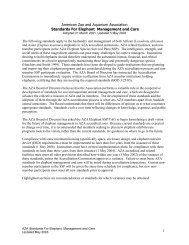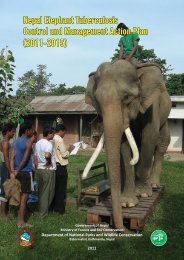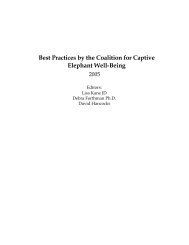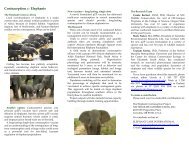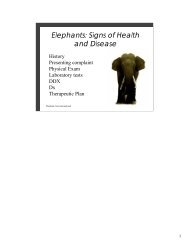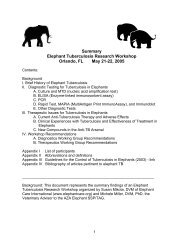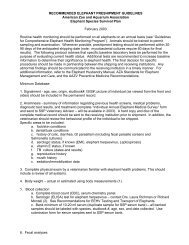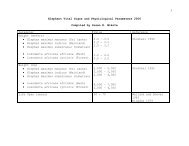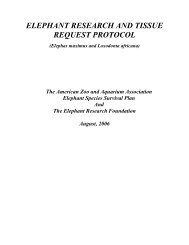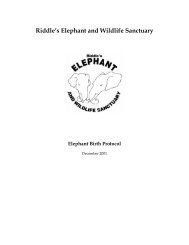Quarantine Guidelines For Elephants 20 - Elephant Care International
Quarantine Guidelines For Elephants 20 - Elephant Care International
Quarantine Guidelines For Elephants 20 - Elephant Care International
You also want an ePaper? Increase the reach of your titles
YUMPU automatically turns print PDFs into web optimized ePapers that Google loves.
QUARANTINE GUIDELINES FOR ELEPHANTS<br />
February, <strong>20</strong>10<br />
Due to the size, strength, and social nature of elephants, it may be logistically difficult to<br />
maintain isolation from other animals during arrival and quarantine. The Recommended<br />
Preshipment Protocol for <strong><strong>Elephant</strong>s</strong> lists a comprehensive battery of tests to detect disease prior<br />
to shipment. Since most zoological institutions will not have facilities available to safely house<br />
and manage a newly arriving elephant, it is important that the receiving institution work closely<br />
with the sending institution to ensure that all (or as many as possible) of the listed tests are<br />
conducted and results reviewed. Following the preshipment protocol may help compensate for<br />
some of the quarantine compromises that may be required. Regardless of preshipment test<br />
results, every attempt should be made to maintain some degree of physical separation from the<br />
resident elephants after arrival.<br />
Current quarantine practices recommend a minimum 30-90 day quarantine period for most<br />
species found in zoos and aquaria. Social concerns, physical facility design, and availability of<br />
trained elephant staff may dictate a modified quarantine protocol. The final decision for specific<br />
quarantine protocols at each institution should be made by the veterinary staff in consultation<br />
with the elephant management staff. <strong>For</strong> additional information, refer to the <strong>Elephant</strong> Husbandry<br />
Manual, AZA <strong>Quarantine</strong> <strong>Guidelines</strong>, and the AAZV Preventive Medicine Recommendations.<br />
The following guidelines provide recommendations for minimum standards for elephant<br />
quarantine.<br />
1. Whenever possible, the newly arrived elephant should be maintained with physical<br />
separation from all other resident elephants. This should include provisions to prevent<br />
contact with feed, bedding, or feces/urine between animals. One option to allow social<br />
interaction is to provide a “companion” and treat both animals as “quarantined”.<br />
2. Initial visual assessment of the elephant, along with review of the medical records, to<br />
determine health status should be used to develop an individual quarantine plan.<br />
Ideally, the recommended length of quarantine is a minimum of 30 days. However,<br />
this may be changed in light of social concerns or detection of abnormal health status.<br />
Risk of disease transmission between animals should be balanced with the concern<br />
for well being (physical, psychological, and social) of the elephant.<br />
3. <strong>Quarantine</strong> procedures should be planned as soon as the elephant can be safely managed and<br />
appears to be settling in the facility. They should include the following:<br />
Thorough physical examination including a review of all systems.<br />
Blood collection for CBC, serum chemistry panel, fibrinogen, serum protein<br />
electrophoresis, and serum bank.<br />
Fecal collection for parasite screening should be done weekly for the first 3 weeks.<br />
Fecal cultures for Salmonella should be conducted at least weekly for the first 3<br />
weeks.<br />
See GUIDELINES FOR COMPREHENSIVE ELEPHANT HEALTH MONITORING<br />
PROGRAM <strong>20</strong>10 for complete list of procedures (www.aazv.org)
Any procedures that were not completed prior to transport or may have come due;<br />
such as vaccination, serologic screening, or TB testing (see “Recommended <strong>Elephant</strong><br />
Preshipment <strong>Guidelines</strong>”).<br />
4. Release from quarantine should be the decision of the veterinary staff (after completion<br />
and review of results from any quarantine procedures), in conjunction with the<br />
assessment of the elephant management staff.<br />
It should be emphasized that the quarantine test requirements should be conducted regardless of<br />
the preshipment testing. The stress of transport and quarantine may result in changes (for<br />
example, Salmonella shedding) that were inapparent during testing at the sending institution.<br />
Contact information:<br />
<strong>Elephant</strong> SSP/TAG Veterinary Advisor<br />
Michele Miller, DVM, PhD<br />
Palm Beach Zoo<br />
1301 Summit Blvd.<br />
West Palm Beach, FL 33405<br />
W: 561-833-7130 ext 224; Cell: 561-727-9630; email: mmiller@palmbeachzoo.org<br />
February <strong>20</strong>10 mm




